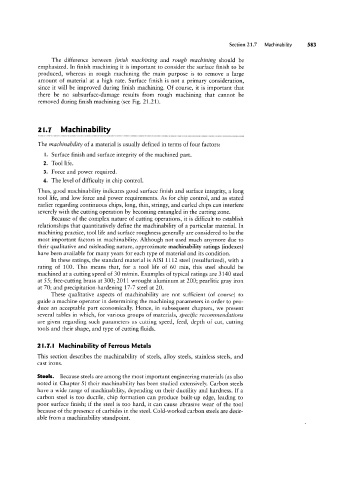Page 602 - 04. Subyek Engineering Materials - Manufacturing, Engineering and Technology SI 6th Edition - Serope Kalpakjian, Stephen Schmid (2009)
P. 602
Section 21 7 Mach|nab|||ty
The difference between finish machining and rough machining should be
emphasized. In finish machining it is important to consider the surface finish to be
produced, whereas in rough machining the main purpose is to remove a large
amount of material at a high rate. Surface finish is not a primary consideration,
since it will be improved during finish machining. Of course, it is important that
there be no subsurface-damage results from rough machining that cannot be
removed during finish machining (see Fig. 21.21).
2" M°°hf_?.?PllfFX __._.____._..______.__ _
The machinability of a material is usually defined in terms of four factors:
l. Surface finish and surface integrity of the machined part.
2. Tool life.
3. Force and power required.
4. The level of difficulty in chip control.
Thus, good machinability indicates good surface finish and surface integrity, a long
tool life, and low force and power requirements. As for chip control, and as stated
earlier regarding continuous chips, long, thin, stringy, and curled chips can interfere
severely with the cutting operation by becoming entangled in the cutting zone.
Because of the complex nature of cutting operations, it is difficult to establish
relationships that quantitatively define the machinability of a particular material. In
machining practice, tool life and surface roughness generally are considered to be the
most important factors in machinability. Although not used much anymore due to
their qualitative and misleading nature, approximate machinability ratings (indexes)
have been available for many years for each type of material and its condition.
In these ratings, the standard material is AISI 1112 steel (resulfurized), with a
rating of 100. This means that, for a tool life of 60 min, this steel should be
machined at a cutting speed of 30 m/min. Examples of typical ratings are 3140 steel
at 55; free-cutting brass at 300; 2011 wrought aluminum at 200; pearlitic gray iron
at 70; and precipitation-hardening 17-7 steel at 20.
These qualitative aspects of machinability are not sufficient (of course) to
guide a machine operator in determining the machining parameters in order to pro-
duce an acceptable part economically. Hence, in subsequent chapters, we present
several tables in which, for various groups of materials, specific recommendations
are given regarding such parameters as cutting speed, feed, depth of cut, cutting
tools and their shape, and type of cutting fluids.
2|.7.l Machinability of Ferrous Metals
This section describes the machinability of steels, alloy steels, stainless steels, and
cast irons.
Steels. Because steels are among the most important engineering materials (as also
noted in Chapter 5) their machinability has been studied extensively. Carbon steels
have a wide range of machinability, depending on their ductility and hardness. If a
carbon steel is too ductile, chip formation can produce built-up edge, leading to
poor surface finish; if the steel is too hard, it can cause abrasive wear of the tool
because of the presence of carbides in the steel. Cold-worked carbon steels are desir-
able from a machinability standpoint.

